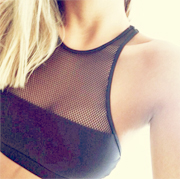Yoga Pose #1
date: 2012-10-31  time: 19:11:37
time: 19:11:37
 time: 19:11:37
time: 19:11:37 Downward Facing Dog - Adho Mukha Svanasana
adho = downward
mukha = face
svana = dog
Step by step
- Come onto the floor on your hands and knees. Set your knees directly below your hips and your hands slightly forward of your shoulders. Spread your palms, index fingers parallel or slightly turned out, and turn your toes under.
- Exhale and lift your knees away from the floor. At first keep the knees slightly bent and the heels lifted away from the floor. Lengthen your tailbone away from the back of your pelvis and press it lightly toward the pubis. Against this resistance, lift the sitting bones toward the ceiling, and from your inner ankles draw the inner legs up into the groins.
- Then with an exhalation, push your top thighs back and stretch your heels onto or down toward the floor. Straighten your knees but be sure not to lock them. Firm the outer thighs and roll the upper thighs inward slightly. Narrow the front of the pelvis.
- Firm the outer arms and press the bases of the index fingers actively into the floor. From these two points lift along your inner arms from the wrists to the tops of the shoulders. Firm your shoulder blades against your back, then widen them and draw them toward the tailbone. Keep the head between the upper arms; don't let it hang.
- Adho Mukha Svanasana is one of the poses in the traditional Sun Salutation sequence. It's also an excellent yoga asana all on its own. Stay in this pose anywhere from 1 to 3 minutes. Then bend your knees to the floor with an exhalation and rest in Child's Pose.

Benefits
- Releases and lengthens neck and spine.
- Calms and stimulates the mind and CNS (Central Nervous System), and helps release stress and mild depression.
- Balancing.
- Strengthens shoulders, arms and legs.
- Cleanses and massages internal organs.
- Tones the sciatic nerve.
- Improves digestion, flow of blood and prana to thyroid, thymus, pituitary, and pineal glands.
- Stimulates the Endocrine system and the 4 upper chakras.
- Improves strength of spine and increases bone density in the spine.
- Stretches shoulders, calves, arches, hands, wrists, ankles, and harmstrings.
- Energizes the body.
- Helps relieve the symptoms of menopause.
- Relieves, headache, insomnia, back pain and fatigue.
- Relieves menstrual discomfort when done with head supported.
- Helps prevent osteoporosis.
- Therapeutic for high blood pressure, asthma, flat feet, sciatica and sinusitis.
Anatomical focus
- Upper back
Beginner's tip
If you have difficulty releasing and opening your shoulders in this pose, raise your hands off the floor on a pair of blocks or the seat of a metal folding chair.
Variations
To challenge yourself in this pose, inhale and raise your right leg parallel to the line of your torso, and hold for 30 seconds, keeping the hips level and pressing through the heel. Release with an exhalation and repeat on the left for the same length of time.
Modifications and props
To get a feel for the work of the outer arms, loop and secure a strap around your arms just above your elbows. Imagine that the strap is tightening inward, pressing the outer arms in against the bones. Against this resistance, push the inner shoulder blades outward.

Partnering
A partner can help you learn how to work the top thighs in this pose. First perform Adho Mukha Svanasana. Have your partner stand behind and loop a strap around your front groins, snuggling the strap into the crease between your top thighs and front pelvis. Your partner can pull on the strap parallel to the line of your spine (remind him/her to extend the arms fully, and keep the knees bent and chest lifted). Release the heads of your thigh bones deeper into your pelvis and lengthen your front torso away from the strap.
Preparatory poses
- Plank pose
- Uttanasana
Follow-up poses
- Standing poses
- Uttanasana
- Headstand
Deepen the pose
To increase the stretch in the backs of your legs, lift slightly up onto the balls of your feet, pulling your heels a half-inch or so away from the floor. Then draw your inner groins deep into the pelvis, lifting actively from the inner heels. Finally, from the height of the groins, lengthen the heels back onto the floor, moving the outer heels faster than the inner.
CONTRAINDICATIONS AND CAUTIONS
- Carpal tunnel syndroms
- Diarrhea
- Pregnancy: Do not do this pose late-term.
- High blood pressure or headache: Support your head on a bolster or block, ears level between the arms.







